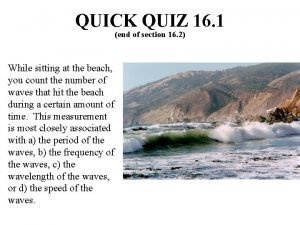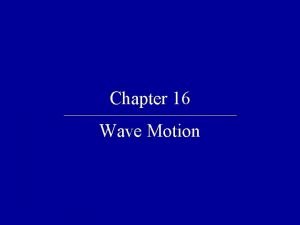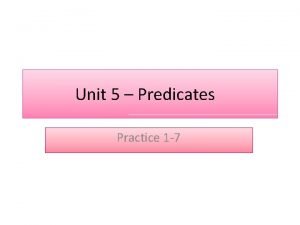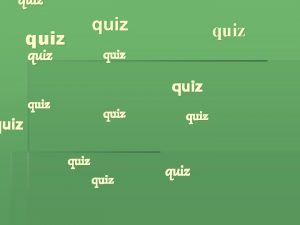QUICK QUIZ 19 1 end of section 19










- Slides: 10

QUICK QUIZ 19. 1 (end of section 19. 1) In a kitchen experiment, you empty a tray of ice cubes into a bowl of water. After an hour or so, when the mixture has come to thermal equilibrium, you notice a little more water in the bowl than you started with and fewer ice cubes in the bowl than you started with. One can say that a) the temperature of the water is slightly higher than the remaining ice cubes, b) the temperature of the water is slightly lower than the remaining ice cubes, c) the temperature of the water is the same as the temperature of the remaining ice cubes, or d) the temperature of the water or the ice cubes depends on the exact mass of water and ice cubes in the bowl.

QUICK QUIZ 19. 1 ANSWER (c). Thermal equilibrium means that the temperature of the water and the ice cubes must be the same. Temperature is the property of an object that defines whether it will be in thermal equilibrium with another object. It does not matter what the composition, state, or phase of the objects are. By the zeroth law, if they have the same temperature, they must be in thermal equilibrium and visa versa.

QUICK QUIZ 19. 2 (end of section 19. 3) The three curves of the figure at right indicate that, for each gas, a) the pressure of the gas is proportional to the temperature of the gas, b) the pressure of the gas is linearly dependent on the temperature of the gas, c) both a and b, or d) neither a nor b.

QUICK QUIZ 19. 2 ANSWER (b). Although only two data points are shown for each gas, the lines are justified in the text of Section 19. 3 by the statement that experiments show a linear relationship between pressure and temperature. However, linear does not necessarily mean proportional. If pressure were proportional to the temperature, this would imply that a doubling of the temperature would be accompanied by a doubling of the pressure. An examination of pressures that correspond to temperatures between 100 and 200°C indicates that this is clearly not the case. For a graph to be proportional it must be linear and have a y intercept that is zero. This criteria is met only for the Kelvin temperature scale where zero temperature is associated with zero pressure.

QUICK QUIZ 19. 3 (end of section 19. 4) You have an option of using one of four differently shaped mercury thermometers to measure temperature changes in a very sensitive experiment. To obtain the highest sensitivity, that is the biggest change in height of the mercury column for a given change in temperature, you should use thermometer a) a, b) b, c) c, d), d or e) a, b, c, or d, each will work equally well.

QUICK QUIZ 19. 3 ANSWER (a). From Equation 19. 6, DV = b. Vi. DT, a large volume change will be associated with a large initial total volume (volume of bulb plus column). For this reason, you would not choose thermometers c or d because of their much smaller total volumes. In addition, you would like to have a narrow column so that a given change in volume is associated with a large change in height. Thermometer “a” best satisfies both of the desired criteria.

QUICK QUIZ 19. 4 (end of section 19. 4) You are designing a railroad and must determine an appropriate gap spacing between adjoining rails to allow for the linear expansion of the rails during hot weather. The rails are made from an alloy of steel with a linear expansion coefficient equal to 10 x 10 -6 (°C-1) and are initially 10 meters long. For a maximum temperature increase of 40°C, Equation 19. 4, DL = a. LDT , yields a change in length, DL = (10 x 10 -6 (°C-1))(10 m)(40°C) = 0. 004 m = 4 mm. So that the rails just touch with a 40°C temperature increase, the gap spacing between adjoining rails should be a) 1 mm, b) 2 mm, c) 4 mm, d) 8 mm, or e) 16 mm.

QUICK QUIZ 19. 4 ANSWER (c). The final length of each rail will be Li + DL. This means that each end of a rail will increase in length by DL/2. In the gap, each adjoining rail will move toward one another by DL/2 which means that the gap should be equal to just DL.

QUICK QUIZ 19. 5 (end of section 19. 5) Using the cylinder shown at right, you measure the initial pressure, volume and temperature of the ideal gas in the container. You then push down on the piston until the pressure increases by a factor of two. If you then measure the temperature of the gas, you will notice that a) it has also increased by a factor of two, b) it has remained constant, c) it has decreased by a factor of two, or d) it is impossible to determine from the given information.

QUICK QUIZ 19. 5 ANSWER (d). The ideal gas law, PV = n. RT, determines the state of the gas in terms of the variables, P, V, n, and T. Since no gas escapes, the number of moles will remain constant so that, Without knowing how the volume changes, it is impossible to determine the change in temperature. For example, the volume could be reduced by a factor of two which would keep the temperature constant. However, it would also be possible for the volume to be reduced by a factor less than or more than two which would be accompanied by an increase or decrease in temperature.
 Chapter 10 section 1 meiosis worksheet answer key
Chapter 10 section 1 meiosis worksheet answer key Quick find vs quick union
Quick find vs quick union The fan blade is speeding up. what are the signs of
The fan blade is speeding up. what are the signs of Section quiz 16-1
Section quiz 16-1 Quick quiz 16 answers
Quick quiz 16 answers Quick personality quiz
Quick personality quiz Semantic roles quiz
Semantic roles quiz Pressure-volume loop
Pressure-volume loop End-diastolic volume vs end-systolic volume
End-diastolic volume vs end-systolic volume Front end of compiler
Front end of compiler Front-end and back-end of compiler
Front-end and back-end of compiler



















